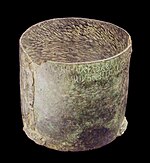Measures and weights in Ancient Rome
The Romans weighed, counted, and measured in pounds, ases, and feet respectively, all divided into twelve units (for example, one as is twelve unciae). Undoubtedly, the Romans opted for the decimal system (still in force and used since the early days of Ancient Egypt, 5,000 years ago) because they could count with the fingers of both hands (one is a finger, five is the open hand, and the ten the two crossed hands, I-V-X). The use of the duodecimal system was used in Mesopotamia, possibly due to the fact of having the phalanges of the fingers, because it is a number divisible by 2, by 3, by 4 and by 6 and, perhaps, because it is associated with the twelve lunar cycles.
In the forum of the Roman cities the mensa ponderaria was kept religiously guarded, with the patterns to contrast the measures and weights used in commercial transactions.
Surface measurements
Surface measurement was the geodesic record (equivalent to half a day's work) and the jugerum (from jugum = 'yoke' or 'yoke', which was equivalent to full day job). An actus was equivalent to 120 square feet. Although theoretically surface measurements, they were rather work measurements. Among others, the Romans, the Greeks and the Egyptians used these measurements.
The heredium corresponded to twice a yugada and therefore, 5039.8m² (around half a hectare) and 100 heredia was a century, which was the unit for the delimitation of the ager publicus.
Measurements of length
Initially the measure of length was the foot divided into twelve parts.
Later, due to Greek influence, the units were changed (only the surface ones persisted) and the Roman foot, which was 24/25 parts of the Greek, was equaled to it. The foot continued to be divided into twelve parts, but the division into four parts (palmus), and into sixteen fingers (digitus) was also introduced.
- Roman Piece
- Roman Milla
Weight measurements
Initially the measure was the pound divided into twelve parts, called ounces, the ounce, in turn, was divided into 24 scruples.
The weights were also put in agreement with the Greeks and four Roman pounds became worth three Attic minas.
Roman capacity measures
The primitive names for the measurements of solids are not known.
The measurements of the bodies were also taken from the Greek:
- Modius 1 modius = 8,754 liters).
- Semodii (0.5 modius or 4,377 litres).
- Congius (3) congius = 1 modius).
- Hemina (both half) Sixthor 32 hemina = 1 modiusor 1 hemina = 0,274 liters).
- Acetabalum (a quarter of hemina, that is, 128 acetabalum = 1 modius or 1 acetabalum = 0.0608 litres).
- Cyathus (192 cyathus = 1 modius).
- They kept it. quartarii (64) quartarii = 1 modiusor 1 quartarii = 0.137 litres) and Sixth (16) Sixth = 1 modius or 1 Sixth = 0.547 litres).
The congius , the Sextarius and the Cyathus were liquid measures, and the last two also served for solids.
Contenido relacionado
834
688
1389
